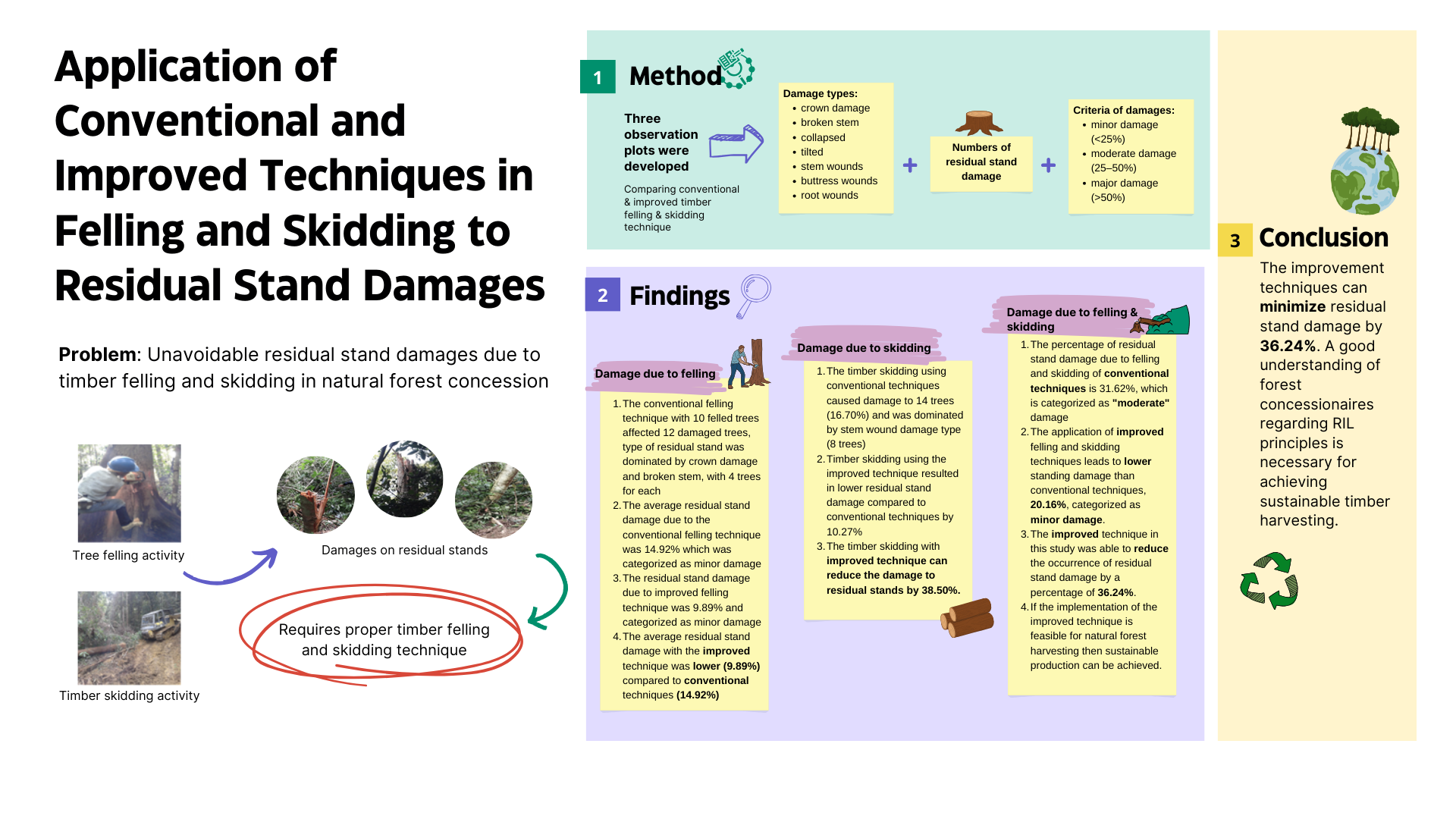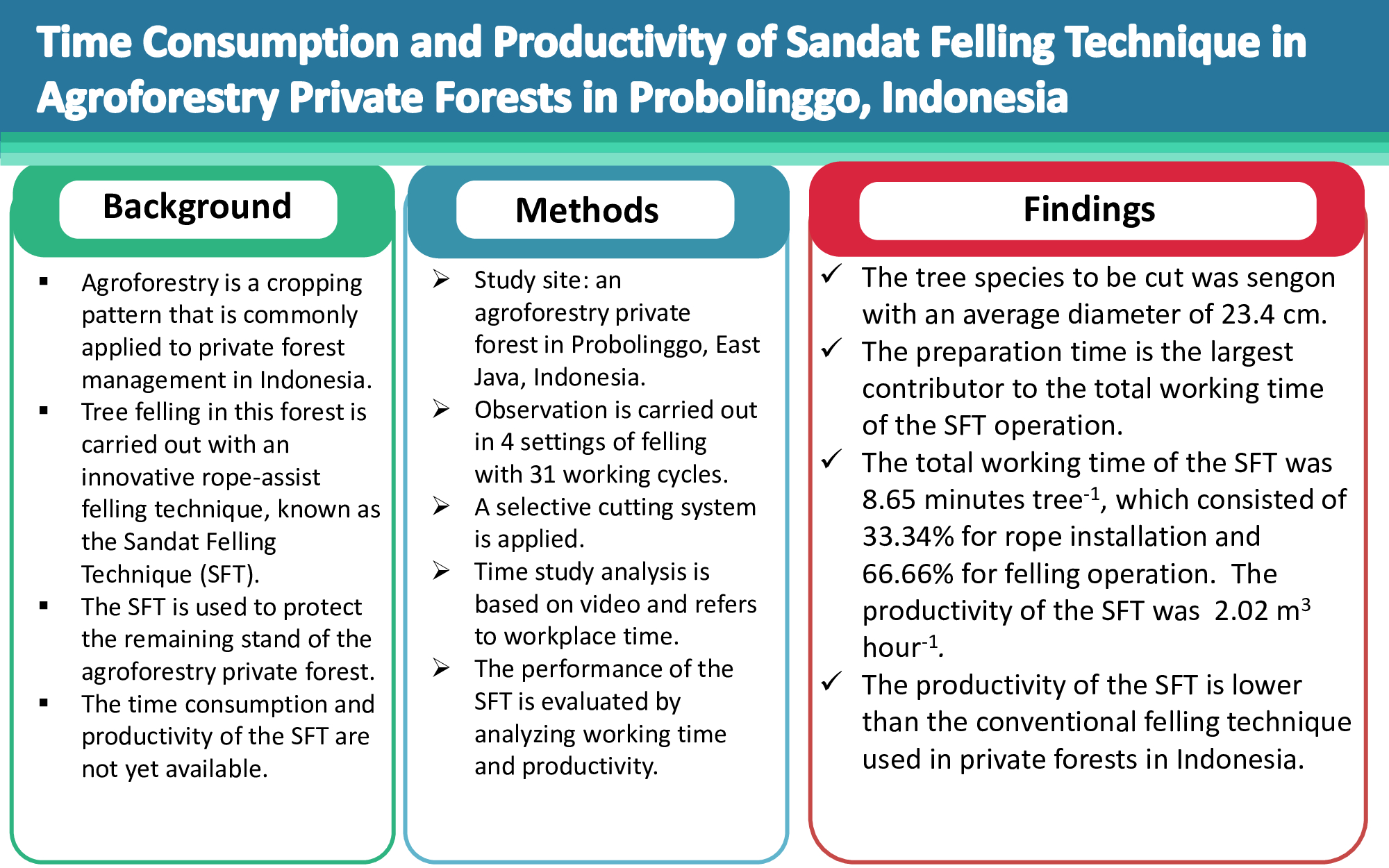Application of Conventional and Improved Techniques in Felling and Skidding to Residual Stand Damages
Abstract
Felling and skidding are essential in the timber extraction process. But on the other hand, residual stand damage can’t be avoided. This study aimed to analyze the impact of conventional and improved felling and skidding techniques on residual stands in natural forests. Three observation plots were developed to identify the types, numbers, and criteria of residual stand damage due to both techniques. The criteria were categorized as a) minor damage (<25%), b) moderate damage (25–50%), and c) major damage (>50%). It showed that the conventional felling and skidding technique caused damages of 14.92% dominated by tree crown damage and 16.70% dominated by stem wounds, respectively. The residual stand damage due to conventional felling and skidding technique was 31.62% categorized as medium damage. Meanwhile, improved felling and skidding techniques caused damage of 9.89% dominated by broken trees, and 10.27% dominated by stem wounds, respectively. The residual stand damage due to improved felling and skidding technique was 20.16% categorized as minor damage. The improvement techniques can minimize residual stand damage by 36.24%. Therefore, a good understanding of forest concessionaires regarding RIL principles is necessary for achieving sustainable timber harvesting
References
Badraghi, N., Erler, J., & Hosseini, S. A. O. (2015). Residual damage in different ground logging methods alongside skid trails and winching strips. Journal of Forest Science, 61(12), 526–534. https://doi.org/10.17221/50/2015-JFS
Bodaghi, A. I., Nikooy, M., Naghdi, R., & Tavankar, F. (2020). Logging damage to residual trees during sustainable harvesting of uneven-age stands in the Hyrcanian forests of Iran. New Zealand Journal of Forestry Science, 50, 1. https://doi.org/10.33494/nzjfs502020x15x
Budiaman, A., Haneda, N. F., Indahwati, Wahyudi, A., Afsari, R., & Gifari, R. (2020). Dampak penyaradan kayu dengan traktor terhadap keanekaragaman semut (Hymenoptera: Formicidae) di hutan produksi alam, Kalimantan Tengah. Jurnal Sylva Lestari, 8(2), 129–143. https://doi.org/10.23960/jsl28129-143
Daniel, T. W., Helms, J. A., & Baker, F. S. (1979). Principles of silviculture (2nd ed). McGraw-Hill.
Danilović, M., Kosovski, M., Gačić, D., Stojnić, D., & Antonić, S. (2015). Damage to residual trees and regeneration during felling and timber extraction in mixed and pure beech stands. Šumarski List, 139(5–6), 253–262.
de Avila, A. L., Schwartz, G., Ruschel, A. R., do Carmo Lopes, J., Silva, J. N. M., de Carvalho, J. O. P., ..., & Bauhus, J. (2017). Recruitment, growth, and recovery of commercial tree species over 30 years following logging and thinning in a tropical rain forest. Forest Ecology and Management, 385, 225–235. https://doi.org/10.1016/j.foreco.2016.11.039
Dudáková, Z., Allman, M., Merganič, J., & Merganičová, K. (2020). Machinery-induced damage to soil and remaining forest stands - A case study from Slovakia. Forests, 11(12), 1289. https://doi.org/10.3390/f11121289
Dulsalam, Soenarno, Suhartana, S., Sukadaryati, Yuniawati, Herniningrum, M., & Andini, S. (2021). Reduced impact logging in the dried land natural production forests in Indonesia. IOP Conference Series: Earth and Environmental Science, 914(1), 012060. https://doi.org/10.1088/1755-1315/914/1/012060
Elias. (1998). Reduced impact timber harvesting in the tropical natural forest in Indonesia. Forest harvesting case study No. 11. Rome: Food and Agriculture Organization of the United Nations.
Elias. (2008). Pembukaan wilayah hutan. Bogor: IPB Press.
Elias, Applegate, G., Kartawinata, K., Machfudh, & Klassen, A. (2001). Reduced impact logging guidelines for Indonesia. Center for International Forestry Research (CIFOR). https://doi.org/10.17528/cifor/001384
Fantini, A. C., & Siminski, A. (2016). Manejo de florestas secundárias da Mata Atlântica para produção de madeira: possível e desejável. RBPG. Revista Brasileira de Pós-Graduação, 13(32), 673–698. https://doi.org/10.21713/2358-2332.2016.v13.1013
Guyon, J. (2017). A guide to identifying, assessing, and managing hazard trees in developed recreational sites of the Northern Rocky Mountains and the Intermountain West. Washington: United States Department of Agriculture.
Hwang, K., Han, H.-S., Marshall, S. E., & Page-Dumroese, D. S. (2018). Amount and location of damage to residual trees from cut-to-length thinning operations in a young redwood forest in Northern California. Forests, 9(6), 352. https://doi.org/10.3390/f9060352
Khai, T. C., Mizoue, N., & Ota, T. (2020). Harvesting intensity and disturbance to residual trees and ground under Myanmar selection system; comparison of four sites. Global Ecology and Conservation, 24, e01214. https://doi.org/10.1016/j.gecco.2020.e01214
Kufre, O. (2018). Sustainability of wood harvesting in the tropical rainforest of Nigeria. Eurasian Journal of Forest Science, 6(2), 44–55. https://doi.org/10.31195/ejejfs.427416
Matangaran, J. R. (2012). Soil compaction by valmet forwarder operation at soil surface with and without slash. Jurnal Manajemen Hutan Tropika, 18(1), 52–59. https://doi.org/10.7226/jtfm.18.1.52
Matangaran, J. R., Aruga, K., Sakurai, R., Iwaoka, M., & Sakai, H. (2006). The recovery of soil compaction in the selection logged over the area at Tokyo University Forest in Hokkaido. The Japan Forest Engineering Society, 21(1), 79–82. https://doi.org/10.18945/jjfes.KJ00007485446
Matangaran, J. R., Putra, E. I., Diatin, I., Mujahid, M., & Adlan, Q. (2019). Residual stand damage from selective logging of tropical forests: A comparative case study in central Kalimantan and West Sumatra, Indonesia. Global Ecology and Conservation, 19, e00688. https://doi.org/10.1016/j.gecco.2019.e00688
Matangaran, J. R., & Suwarna, U. (2012). Kepadatan tanah oleh dua jenis forwarder dalam pemanenan hutan. Bionatura-Jurnal Ilmu-Ilmu Hayati dan Fisik, 14(2), 115–124.
Muhdi. (2016). Pemadatan tanah akibat penyaradan kayu dengan traktor Catterpillar D7G di areal hutan produksi PT Inhutani II, Kalimantan Utara. Jurnal Pertanian Tropik, 3(1), 17–24. https://doi.org/10.32734/jpt.v3i1.2952
Muhdi, M., Hanafiah, D., Lubis, W., Telaumbanua, A., & Atika, D. (2020). Chainsaw operators perception on occupational health and safety (OHS) in industrial plantation forest, North Sumatra, Indonesia. In Sriadhi, K. Budiartia, A. Zainal, & H. Fibriasari (Eds.), IC2RSE 2019. The 3rd international conference community research and service engagements (pp. 1–6). EAI. https://doi.org/10.4108/eai.4-12-2019.2293807
Nikooy, M., Tavankar, F., Naghdi, R., Ghorbani, A., Jourgholami, M., & Picchio, R. (2020). Soil impacts and residual stand damage from thinning operations. International Journal of Forest Engineering, 31(2), 126–137. https://doi.org/10.1080/14942119.2020.1744954
Purwoko, A., Muhdi, M., & Hanafiah, A. S. (2018). Residual stand damages caused by conventional and reduced impact timber harvesting in the natural forest. International Journal of Mechanical Engineering and Technology, 9(3), 313–325.
Roopsind, A., Caughlin, T. T., van der Hout, P., Arets, E., & Putz, F. E. (2018). Trade‐offs between carbon stocks and timber recovery in tropical forests are mediated by logging intensity. Global Change Biology, 24(7), 2862–2874. https://doi.org/10.1111/gcb.14155
Soenarno, Endom, W., & Bustomi, S. (2017). Kerusakan tegakan tinggal akibat pemanenan kayu pada hutan tropis berbukit di Kalimantan Tengah. Jurnal Penelitian Hasil Hutan, 35(4), 273–288. https://doi.org/10.20886/jphh.2017.35.3.273-288
Venturoli, F., Franco, A. C., & Fagg, C. W. (2015). Tree diameter growth following silvicultural treatments in a semi-deciduous secondary forest in Central Brazil. Cerne, 21, 117–123. https://doi.org/10.1590/01047760201521011204
Vidal, E., West, T. A. P., & Putz, F. E. (2016). Recovery of biomass and merchantable timber volumes twenty years after conventional and reduced-impact logging in Amazonian Brazil. Forest Ecology and Management, 376, 1–8. https://doi.org/10.1016/j.foreco.2016.06.003
Wahyudi, Mojiol, A. R., Rahmawati, R., Nursiah, & E, P. P. (2020). Tingkat kerusakan tegakan tinggal pada areal bekas tebangan di IUPHHK-HA PT Gunung Meranti, Provinsi Kalimantan Tengah. Hutan Tropika, 15(2), 70–79.
Yovi, E. Y., & Amanda, N. (2020). Ergonomic analysis of traditional pine oleoresin tapping: Musculoskeletal disorders, cumulative fatigue, and job satisfaction. Jurnal Sylva Lestari, 8(3), 283–296. https://doi.org/10.23960/jsl38283-296
Yovi, E. Y., Gandaseca, S., & Adiputra, N. I. (2012). Worker’s competency and perception toward safety and health on forest harvesting operation in Indonesian long rotation plantation forest. Jurnal Manajemen Hutan Tropika, 18(3), 198–205. https://doi.org/10.7226/jtfm.18.3.198
Yovi, E. Y., Yamada, Y., Zaini, M. F., Yonanda Kusuma Dewi, C. A., & Marisiana, L. (2016). Improving the OSH knowledge of Indonesian forestry workers by using safety game application : tree felling supervisors and operators. Jurnal Manajemen Hutan Tropika, 22(1), 75–83. https://doi.org/https://doi.org/10.7226/jtfm.22.1.75
Authors

This work is licensed under a Creative Commons Attribution 4.0 International License.
Jurnal Manajemen Hutan Tropika is an open access journal which means that all contents is freely available without charge to the user or his/her institution. Users are allowed to read, download, copy, distribute, print, search, or link to the full texts of the articles in this journal without asking prior permission from the publisher or the author. This is in accordance with the Budapest Open Access Initiative (BOAI) definition of open access.





